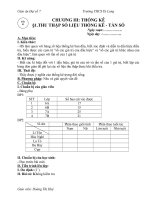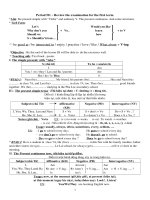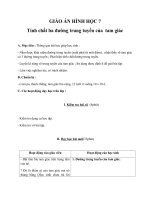7 weeks to 50 pull ups
Bạn đang xem bản rút gọn của tài liệu. Xem và tải ngay bản đầy đủ của tài liệu tại đây (4.96 MB, 269 trang )
Table of Contents
Title Page
Dedication
PART I: OVERVIEW
Introduction
How Pull-Ups Changed My Life
About the Book
What Is a Pull-Up?
The Muscles behind the Movement
Why Pull-Ups?
Pull-Ups in the Military
Frequently Asked Questions
Before You Begin
Warming Up and Stretching
Avoiding Injuries
12 Tips for Success
Initial Test
PART II: THE PROGRAMS
The 50 Pull-Ups Program
Grips and Hand Positions
Reading the workout charts
7-Week Program: Phase I
Phase I Test
7-Week Program: Phase II
Fifty Pull-Up Test
PART III: BEYOND 50 PULL-UPS
Maintaining Your Physique with Pull-Ups
Advanced Pull-Ups
5-Up, 5-Down Pull-ups
Side-to-Side Pull-Up
Mixed-Grip Pull-Up
Mixed-Grip “Commando” Pull-Up
Neutral-Grip Pull-Up with Leg Raise
Towel Pull-Up
Weighted Pull-Up
Hanging Leg Raise
90°-Arm Hang with Leg Raise
APPENDIX
Index
Acknowledgements
About the Author
Copyright Page
This book is dedicated to my wonderful
wife Kristen, who has put up with all my
crazy training and events over the years.
Without her support, my fitness lifestyle
would never be possible.
Introduction
We all want to be lean, fit and healthy, right? But
how can you choose the workout plan that will
yield the best results in the least amount of time?
The hardest part of exercise may not even be the
workout—it may be finding the time to stick with
your new routine.
efficient way to work your entire upper body and
core in less than 20 minutes a day, 3 days a week
—with no special training or fancy equipment!
You can strengthen and sculpt your arms,
shoulders, back and abs by following a
progressive training program using pull-ups. 7
Weeks to 50 Pull-Ups features that routine—and
much more. The routines contained in this book
will detail the plentiful benefits of pull-ups, such
as vastly improved muscular endurance in your
upper body, arms and core, more lean muscle, and
a metabolism fired up to burn any excess fat.
I’ll say it again: 20 minutes a day, 3 days a
week. It’s important that a workout be easy to
follow, quick, and show results almost
immediately. If an exercise is too difficult to
follow or remember off the top of your head, you
just won’t stick to it. And if you don’t see results
quickly, you’re likely to give it up—like all those
other fitness goals and plans that you probably
didn’t finish. So, believe me when I tell you that if
you follow this program, you’ll feel the results
immediately and be well on your way to a leaner,
fitter, healthier you.
MOST PULL-UPS IN 1 MINUTE
(MALE): 50 (TIE)
Jason Petzold (USA)
June 20, 2009, in Millington, Michigan
Matthew Bogdanowicz (USA)
Nov. 12, 2009, in Castro Valley,
California
MOST PULL-UPS IN 1 MINUTE
(FEMALE): 37
Alicia Weber (USA)
May 27, 2010, in Clermont, Florida
How Pull-Ups Changed My Life
“Pull-up.” The word alone is enough to scare a
middle-school kid in gym class. Throughout school
I dreaded each fall when we would perform the
Presidential Physical Fitness Test (see page 39). I
was adequate at sit-ups, push-ups and even the
shuttle run, but I was never able to squeak out even
one pull-up.
For years I was afraid to even think about
attempting a pull-up at the playground, and, as I got
older, even more so at a gym. I used to watch in
amazement from the other side of the gym as the fit
guys did their sets. I’d secretly count their
repetitions—I guess I was a pull-up stalker. Every
so often I’d reach up and grab the pull-up bar and
attempt to do one rep. When I failed to pull myself
all the way up, I’d make it look like I was just
stretching. Call me vain but I really wanted to
knock out a set often in front of everyone at the
gym. I just never really envisioned that I could
actually do it.
Today, at almost 40 years old, I do anywhere
from 50–100 pull-ups at every workout.
How did I do it? I stopped wishing I could do a
pull-up and started a progressive training program
that reshaped my fitness and my life. 7 Weeks to 50
Pull-Ups was created directly from that program.
It incorporates routines for individuals of any age,
gender and ability who want to take their fitness to
new levels.
About the Book
7 Weeks to 50 Pull-Ups is built on a flexible
program that can benefit men and women alike. It’s
an easy-to-follow progressive training program
designed to take you from your current fitness level
to a level where you can complete as many as 50
pull-ups in one workout. The book provides three
levels that are suitable for everyone regardless of
age, gender or ability.
Because this type of workout requires you to lift
your entire body weight, you’ll need to find a
balanced ratio of strength to weight. If your body
has excess weight, it’ll obviously be harder to
perform the pull-ups. The good news is that
working through the levels of the program will
help you lose weight due to a revved-up
metabolism and the growth of lean muscl Sticking
with and completing the program at any level will
help you build a stronger body and sculpt your
physique in just 20 minutes a day, 3 days a week.
Since the hardest part of any new fitness
regimen is the first step, I’d like to save you some
time and effort by getting some common excuses
out of the way right now.
THE EXCUSE: “I’m not going to
do pull-ups at a gym—too many
people will see me fail!”
SOLUTION: Start out in the
privacy of your home. Most
sporting goods stores have
inexpensive pull-up bars that work
in a doorway or basement.
THE EXCUSE: “I can’t even do
one pull-up.”
SOLUTION: You don’t have to be
able to do any pull-ups to start. The
Prep-Level Program features
multiple exercises to prepare you
for pull-ups and build your strength
and confidence.
THE EXCUSE: “This is probably
too hard for a beginner.”
SOLUTION: Nonsense. These are
tried and true exercises that anyone
can do, with variations for
beginners, fitness professionals,
and everyone in between.
THE EXCUSE: “I don’t have
enough time in my busy schedule to
follow a routine.”
SOLUTION: 7 Weeks to 50 Pull-
Ups is built around a 15–20 minute
workout (with breaks between sets)
performed only three days a week.
The workout is very easy to
integrate into your life. You can
even do sets while getting ready in
the morning.
With those excuses out of the way, here’s what you
can expect from this book.
PART 1 introduces the program and takes the
fear out of pull-ups by explaining the proper form.
You’ll learn the health and fitness benefits and the
answers to any lingering questions you may have.
The goal of Part 1 is to get you ready for a regimen
that will transform your body and change your life.
The first step consists of preparation, warming
up/stretching and taking the initial pull-up test.
PART 2 gets you started on the training plans
for every age, gender and ability. They’re broken
down into Phase I and Phase II. Each level has its
own specific exercise plan and duration, and each
level builds on the previous one to help you reach
your goal.
MOST PULL-UPS IN 30 MINUTES
(MALE): 543
Stephen Hyland (Great Britain)
July 5, 2010, in Surrey, England
MOST PULL-UPS IN 30 MINUTES
(FEMALE): 398
Alicia Weber (USA)
Feb. 6, 2010, in Clermont, Florida
PART 3 showcases some alternative workouts
that employ different pull-up grips and motions.
These alternatives will provide even more impact
on specific muscle groups. Part 3 also provides a
maintenance plan to keep you fit in between.
THE APPENDIX features workout logs so you
can track your progress throughout the plan. It also
presents warm-up exercises and stretches, as well
as the Prep-Level Program, which is designed for
those who can’t yet do a single pull-up.
In addition, throughout the book you’ll learn
interesting pull-up facts, records and tips on
improving your form.
The first image that comes to mind when you think
of a pull-up is possibly a red-faced drill sergeant
screaming in a cadet’s face as he or she struggles
to pull his or her chest up to the bar for one more
repetition. This compound strength-training pulling
exercise is one of the defining moments of basic
training—and for good reason. Being fit enough to
pull one’s body weight up and over obstacles is
critically important for a soldier. This level of
fitness is important for civilians too.
PULL-UPS ILLUSTRATED
Pictures of seven pull-up variations
from easiest to hardest (left to right)
a fixed bar using an overhand (pronated) grip, then
pull yourself up until your elbows are bent, your
head is higher than your hands and the bar is at
shoulder height. This action targets all the major
muscle groups of the upper body, requiring them to
work together to complete the movement.
Pull-ups can be performed using several
different hand grips, with each grip targeting
certain muscle groups more than others. For
instance, an underhand pull-up (commonly known
as a chin-up) recruits the biceps more than the
wide-grip pull-up. Our goal is to crank out 50
standard pull-ups in seven weeks.
The Muscles behind the Movement
This compound exercise requires that several
muscle groups work together and includes
movements around two joints (the shoulder and the
elbow). When you do a pull-up, you first use the
many muscles of the hand and forearm to grip the
bar. Strengthening these muscles is important for
everyday tasks, whether you use a computer all day
or perform manual labor. You then utilize the
larger muscles of the upper arm, shoulders and
back:
LATISSIMUS DORSI One of the









